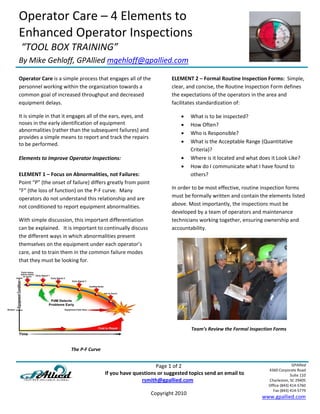
Tool Box Training-Operator Care
- 1. Operator Care – 4 Elements to Enhanced Operator Inspections “TOOL BOX TRAINING” By Mike Gehloff, GPAllied mgehloff@gpallied.com Operator Care is a simple process that engages all of the ELEMENT 2 – Formal Routine Inspection Forms: Simple, personnel working within the organization towards a clear, and concise, the Routine Inspection Form defines common goal of increased throughput and decreased the expectations of the operators in the area and equipment delays. facilitates standardization of: It is simple in that it engages all of the ears, eyes, and What is to be inspected? noses in the early identification of equipment How Often? abnormalities (rather than the subsequent failures) and Who is Responsible? provides a simple means to report and track the repairs to be performed. What is the Acceptable Range (Quantitative Criteria)? Elements to Improve Operator Inspections: Where is it located and what does it Look Like? How do I communicate what I have found to ELEMENT 1 – Focus on Abnormalities, not Failures: others? Point “P” (the onset of failure) differs greatly from point “F” (the loss of function) on the P‐F curve. Many In order to be most effective, routine inspection forms operators do not understand this relationship and are must be formally written and contain the elements listed not conditioned to report equipment abnormalities. above. Most importantly, the inspections must be developed by a team of operators and maintenance With simple discussion, this important differentiation technicians working together, ensuring ownership and can be explained. It is important to continually discuss accountability. the different ways in which abnormalities present themselves on the equipment under each operator’s care, and to train them in the common failure modes that they must be looking for. Team’s Review the Formal Inspection Forms The P‐F Curve Page 1 of 2 GPAllied 4360 Corporate Road If you have questions or suggested topics send an email to Suite 110 rsmith@gpallied.com Charleston, SC 29405 Office (843) 414‐5760 Fax (843) 414‐5779 Copyright 2010 www.gpallied.com
- 2. Operator Care – 4 Elements to Enhanced Operator Inspections “TOOL BOX TRAINING” By Mike Gehloff, GPAllied mgehloff@gpallied.com ELEMENT 3 – Ensure Inspections are Quantitative: ELEMENT 4 – Liberal use of Visual Controls: A quantitative inspection is one that can be performed in Visual controls can be used to: a standardized, repeatable, and measureable way by Improve the Speed and Accuracy of Inspection every operator. Quantitative inspections include some Reduce Confusion numeric criteria whenever possible (pressure, temp., Ensure Consistency level, etc.), or a detailed description what we would expect to see. Quantitative inspections are often Simple applications such as the marking of gauges and enhanced with pictures or sketches. level indicators, match marking base bolts, or labeling equipment can greatly enhance inspection performance Subjective Inspection: “Check Gearbox” and engagement. Quantitative Inspection: “Ensure Oil Level ½” - ¾” in Sight Glass” These quantitative descriptions are built into the routine inspection forms used by the operators. In certain applications it is challenging to describe the desirable (or undesirable) condition. In these situations the use of photographs greatly improves the inspection process. Teams Applying Visual Controls Conclusion: Organizations that fail to engage the operators in their asset care strategies are missing a great opportunity to identify and address abnormalities early in the failure process. Our experience shows that operators are ready and willing to be part of the total asset care strategy if we: Engage Them Directly Value their Input Work Cooperatively to Define Clear Expectations Make it Visual Follow Up on Reported Problems in a Timely Manner A One Point Lesson Page 2 of 2 GPAllied 4360 Corporate Road If you have questions or suggested topics send an email to Suite 110 rsmith@gpallied.com Charleston, SC 29405 Office (843) 414‐5760 Fax (843) 414‐5779 Copyright 2010 www.gpallied.com
